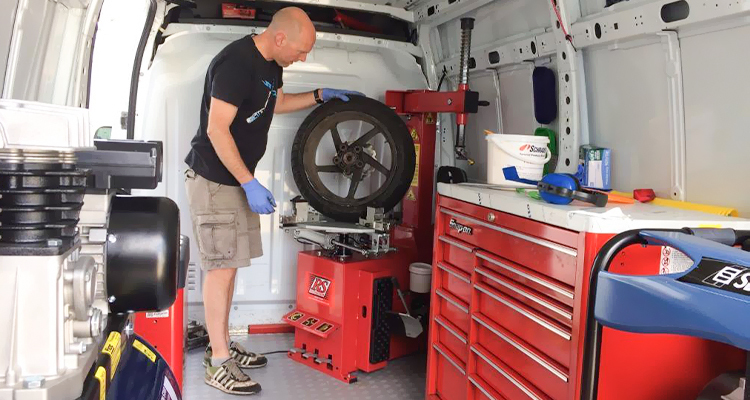Tire Service: Proven Approaches for Optimum Tire Upkeep and Treatment
From ensuring appropriate tire stress to normal rotation and positioning, there are tried and tested methods that can significantly prolong the life-span of your tires and enhance general driving experience. Let's dig right into the globe of tire service and find the tricks to maintaining your tires in top-notch form for the lengthy haul - Mobile Tire Change Las Vegas.
Relevance of Tire Stress
Proper tire stress is a critical consider making sure ideal automobile efficiency and safety and security when traveling. Preserving the suggested tire pressure levels given by the supplier supplies numerous benefits. First of all, adequate tire pressure advertises better gas effectiveness, as under-inflated tires can cause boosted rolling resistance, triggering the engine to work tougher and eat even more fuel. Correct tire stress makes sure also walk wear, enhancing tire long life and saving money in the lengthy run by delaying the need for premature replacements. In addition, appropriately pumped up tires add to enhanced handling and braking abilities, important for secure driving in different road problems. Over-inflated tires, on the other hand, can cause reduced grip and a harsher ride. Alternatively, under-inflated tires are prone to getting too hot, which can lead to mishaps and blowouts. On a regular basis examining and changing tire stress, especially eventually journeys, is a simple yet effective method to boost vehicle efficiency, prolong tire lifespan, and focus on safety and security when traveling.
Tire Turning Guidelines
When considering tire rotation standards, it is important to understand the significance of this maintenance job in optimizing tire life expectancy and maintaining ideal lorry performance. Tire turning entails changing the placement of each tire on a lorry to ensure even tread wear. Front tires tend to put on a lot more promptly than rear tires due to steering pressures, making routine rotation important for balanced wear patterns. The suggested rotation pattern varies depending upon whether a lorry is front-wheel, rear-wheel, all-wheel, or four-wheel drive. Generally, tires ought to be turned every 5,000 to 7,500 miles, or as recommended in the car guidebook. Disregarding tire rotation can bring about uneven wear, affecting handling, grip, and potentially compromising car safety. By adhering to proper turning standards, drivers can extend the life of their tires, enhance fuel effectiveness, and improve general driving experience. Normal rotation is a straightforward yet efficient upkeep technique that adds significantly to tire long life and vehicle performance.

Advantages of Wheel Placement
Guaranteeing correct wheel placement after tire rotation is vital for maintaining well balanced wear patterns and maximizing vehicle performance. In addition, correct wheel positioning aids to expand the lifespan of your tires. Misaligned wheels can trigger irregular tire wear, leading to early tire substitute and increased maintenance expenses.

Tire Tread Deepness Check
Performing a normal assessment of tire walk deepness is necessary for preserving risk-free driving conditions and lengthening the lifespan of your tires. click Irregular walk wear can suggest issues with tire suspension, placement, or pressure, highlighting the importance of normal step depth checks. By including tire tread deepness checks into your regular upkeep routine, you can drive with view website confidence recognizing that your tires are in top problem.
Seasonal Tire Examination
Seasonal tire assessment is an essential element of tire maintenance that guarantees tires are ready to encounter the obstacles posed by various climate problems. In prep work for wintertime, it is necessary to examine the tire pressure regularly as chilly temperature levels can cause tire pressure to drop. By performing routine seasonal tire evaluations, vehicle drivers can prolong tire lifespan, boost fuel performance, and most notably, make sure a safe and secure driving experience in varying weather problems.
Conclusion
Finally, preserving appropriate tire pressure, revolving tires on a regular basis, aligning wheels appropriately, monitoring tread deepness, and conducting seasonal examinations are vital methods for ideal tire treatment. By complying with these confirmed techniques, vehicle drivers can ensure their tires last longer, execute better, and add to overall automobile safety and security. It is essential to prioritize tire upkeep to avoid mishaps, boost fuel efficiency, and extend the life-span of tires.
Adequate tire pressure advertises much better fuel effectiveness, as under-inflated tires can lead to raised rolling resistance, causing the engine to work more difficult and take in more fuel.When thinking about tire turning standards, it is crucial to recognize the value of this upkeep job in making the most of tire life expectancy and preserving optimal lorry efficiency. Seasonal tire examination is a basic facet of tire upkeep that guarantees tires are ready to face the challenges posed by different climate conditions. By performing regular seasonal tire examinations, drivers can lengthen tire life-span, boost fuel efficiency, and most importantly, ensure a secure driving experience in differing climate conditions.
In conclusion, keeping correct tire pressure, rotating tires routinely, lining up wheels correctly, monitoring step deepness, and carrying out seasonal evaluations are essential techniques for ideal tire care.